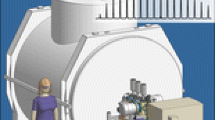Abstract
Dipolar and single-phase two-electrode quadrupolar detection schemes have been investigated at a Fourier transform ion cyclotron resonance mass spectrometry (FT-ICR MS) setup built for the KATRIN experiment at the Max-Planck-Institute for Nuclear Physics (MPIK) in Heidelberg. We present first experimental results of 7Li + signals from a cylindrical Penning trap configuration for both detection schemes. While the prominent signal of the conventional dipolar detection scheme marks the reduced cyclotron frequency, the main signal for the quadrupolar detection appears at the sum of the reduced cyclotron frequency and the magnetron frequency. For ideal trapping fields, this sum frequency equals the ion cyclotron frequency ν c = qB/(2πm). Sidebands due to the combined motions of the cyclotron mode and magnetron mode are observed by quadrupolar detection which allows the determination of the respective combinations of eigenfrequencies.
Similar content being viewed by others
References
Ghosh, P.K.: Ion Traps. International series of monographs on physics 90, Clarendon Press, Oxford (1995) ISBN: 0-19-853995-9
Major, F.G., Gheorghe, V., Werth, G.: Charged Particle Traps. Springer, Heidelberg (2005)
Brown, L.S., Gabrielse, G.: Geonium theory: physics of a single electron or ion in a Penning trap. Rev. Mod. Phys. 58, 233 (1986)
Gabrielse, G.: The true cyclotron frequency for particles and ions in a Penning trap. Int. J. Mass Spectrom. 279, 107 (2009)
Blaum, K.: High-accuracy mass spectrometry with stored ions. Phys. Rep. 425, 1 (2006)
Blaum, K., Novikov, Yu. N., Werth, G.: Penning traps as a versatile tool for precise experiments in fundamental physics. Cont. Phys. 51, 149 (2010)
Schweikhard, L., Bollen, G. (eds.): Ultra accurate mass spectrometry and related topics. Int. J. Mass Spectrom. (Special issue) 251, (2006)
Mukherjee, M., et al.: ISOLTRAP: an on-line Penning trap for mass spectrometry on short-lived nuclides. Eur. Phys. J. A35, 1 (2008)
Ringle, R., et al.: Precision mass measurement with LEBIT at MSU. Int. J. Mass Spectrom. 251, 300 (2006)
Clark, J., et al.: Improvements in the injection system of the Canadian Penning trap mass spectrometer. Nucl. Instrum. Methods B 204, 487 (2003)
Dilling, J., et al.: Mass measurements on highly charged radioactive ions, a new approach to high precision with TITAN. Int. J. Mass Spectrom. 251, 198 (2006)
Ketelaer, J., et al.: TIGA-SPEC: A setup for mass spectrometry and laser spectroscopy at the research reactor TRIGA Mainz. Nucl. Instrum. Methods A 594, 162 (2008)
Jokinen, A., et al.: Precision experiments on exotic nuclei at IGISOL. Int. J. Mass Spectrom. 251, 204 (2006)
Block, M., et al.: Direct mass measurement above uranium bridge the gap to the island of stability. Nature 463, 785 (2010)
Rauth, C., et al.: Direct mass measurements around A=146 at SHIPTRAP. Eur. Phys. J. (Special Topics) 150, 329 (2007)
Graeff, G., Kalinowsky, H., Traut, J.: A direct determination of the proton electron mass ratio. Z. Phys. A 297, 35 (1980)
Comisarow, M.B., Marshall, A.G.: Fourier transform ion cyclotron resonance spectroscopy. J. Chem. Phys. 25, 282 (1974)
Comisarow, M.B.: Fundamental aspects of FT-ICR and application to chemistry. Hyperfine Interact. 81, 171 (1993)
Marshall, A.G., Hendrickson, C.L., Jackson, G.S.: Fourier transform ion cyclotron resonance mass spectroscopy: a primer. Mass Spectrom. Rev. 17, 1 (1998)
Dunbar, R.C.: The effect of ion position on ICR signal strength. Int. J. Mass Spectrom. Ion Process. 56, 1 (1983)
Otten, E.W., Weinheimer, C.: Neutrino mass limit from tritium β decay. Rep. Prog. Phys. 71, 086201 (2008)
Ubieto-Díaz, M., Rodríguez, D., Lukic, S., Nagy, Sz., Stahl, S., Blaum, K.: A broad-band FT-ICR Penning trap system for KATRIN. Int. J. Mass Spectrom. 288, 1 (2009)
Ketelaer, J., et al.: Recent developments in ion detection techniques for Penning trap mass spectrometry at TRIGA-TRAP. Eur. Phys. J. A42, 311 (2009)
Eitel, G., et al.: Position-sensitive ion detection in precision Penning trap mass spectrometry. Nucl. Instrum. Methods A 606, 474 (2009)
Rodríguez, D., Blaum, K., Cakirli, R.B., Heck, M., Schweikhard, L., Stahl, S., Ubieto-Díaz, M.: Broad-band FT-ICR MS for the Penning-trap mass spectrometer MATS. AIP Conf. Proc. 1265, 483 (2010)
Martinez, F., Herlert, A., Marx, G., Schweikhard, L., Walsh, N.: Unintended parametric ejection of ions from an ion cyclotron resonance trap by two-electrode axialization. Eur. J. Mass Spectrom. 15, 283 (2009)
Schweikhard, L., Lindinger, M., Kluge, H.-J.: Quadrupole-detection FT-ICR mass spectrometry. Int. J. Mass Spectrom. Ion Process. 98, 25 (1990)
Schweikhard, L., Blundschling, M., Jertz, R., Kluge, H.-J.: A new detection scheme for Fourier transform-ion cyclotron resonance spectrometry in Penning traps. Rev. Sci. Instrum. 60, 2631 (1989)
Schweikhard, L.: Theory of quadrupole detection Fourier transform ion cyclotron resonance. Int. J. Mass Spectrom. Ion Procees. 107, 281 (1991)
Schweikhard, L., Marshall, A.G.: Excitation modes for Fourier transform-ion cyclotron resonance mass spectrometry. J. Am. Soc. Mass Spectrom. 4, 433 (1993)
Author information
Authors and Affiliations
Corresponding author
Rights and permissions
About this article
Cite this article
Heck, M., Blaum, K., Cakirli, R.B. et al. Dipolar and quadrupolar detection using an FT-ICR MS setup at the MPIK Heidelberg. Hyperfine Interact 199, 347–355 (2011). https://doi.org/10.1007/s10751-011-0330-8
Published:
Issue Date:
DOI: https://doi.org/10.1007/s10751-011-0330-8



